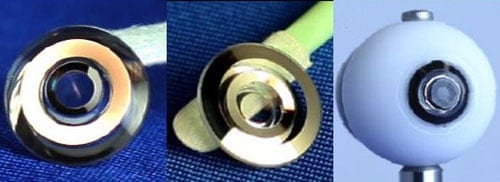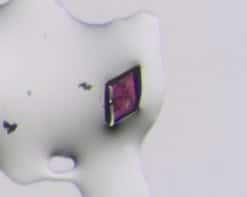
An international team of researchers has built a telescopic contact lens that can switch between normal and magnified vision. Along with refinements and a pair of commercially available liquid-crystal glasses, the system could offer people with retinal problems, such as age-related macular degeneration (AMD), a relatively unobtrusive way to enhance their vision.
AMD is a medical condition that leads to the gradual loss of central vision caused by retinal damage. It is the leading cause of blindness among older adults in the western world. Patients suffer from blurry vision – with particular difficulty in reading and recognizing faces as the disease progresses – although their peripheral vision remains unaffected. Regular contact lenses do not provide any relief because they cannot restore the lost vision merely by correcting the eye’s focus.
Instead, sufferers use other types of devices that magnify incoming light and distribute it to undamaged parts of the retina. Help usually comes in the form of rather bulky spectacle-mounted telescopes or surgical implants within the eye – the latter being an intrusive and expensive procedure.
Unobtrusive aid
To fill the niche between surgery and the bulky mount, optical-engineer Eric Tremblay of the Ecole Polytechnique Fédérale de Lausanne (EPFL) in Switzerland, along with colleagues in the US, has designed and built the first contact lens that incorporates a telescope. Tremblay’s new system uses tightly fitting mirror surfaces to make a telescope that is integrated into a contact lens just over a millimetre thick. The lenses’ arrangement is such that it has two modes. The centre of the lens provides unmagnified vision, while the ring-shaped telescope, which is at the periphery of the regular contact lens, magnifies the view 2.8 times.
“A user can switch between normal and magnified vision…and to do this switching, you would use a pair of off-the-shelf 3D TV glasses that we have modified slightly,” explains Tremblay. He tells physicsworld.com that the polarizing filters within these glasses selectively block light to either section of the lens.

After designing the lens, the team built and tested it using both computer-modelling and by creating a life-sized model eye that captured images while the lens was in use. The results showed the magnified image quality to be clear and a substantially larger field-of-view than other magnification techniques was observed. The image above shows both the magnified and normal views. The central image, taken without a filter of any kind, is greatly reduced in contrast.
Day-long wear
Tremblay says that the team is currently making some necessary refinements to the system before it can be used by consumers. “We built our prototype lens using a plastic material called polymethyl methacrylate [PMMA] that is quite robust,” he explains, to allow for some manufacturing aspects. But PMMA is not ideal for contact lenses because it is “gas-impermeable”, making it unsuitable for long-term wear.
“We are now trying to build the lens using standard contact-lens materials that are gas-permeable…these will ensure that the cornea is receiving plenty of oxygen and so can be used safely all day long,” explains Tremblay. Tremblay and the rest of the team are currently working with two companies based in the US – Paragon Vision Sciences and Innovega – that specialize in building contact-lens solutions for visual impairments, to build their new lens. Depending on the results of tests with the newly fabricated lens, Tremblay hopes that clinical trials using the lens could be carried out by the end of this year.
The research is published in Optics Express.



